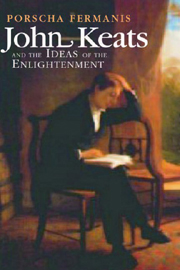Book contents
- Frontmatter
- Contents
- Acknowledgements
- Abbreviations
- Introduction: Keats, Enlightenment and Romanticism
- 1 Ancients and Moderns: Literary History and the ‘Grand March of Intellect’ in Keats's Letters and the 1817 Poems
- 2 Civil Society: Sentimental History and Enlightenment Socialisation in Endymion and The Eve of St. Agnes
- 3 The Science of Man: Anthropological Speculation and Stadial Theory in Hyperion
- 4 Political Economy: Commerce, Civic Tradition and the Luxury Debate in Isabella and Lamia
- 5 Moral Philosophy: Sympathetic Identification, Utility and the Natural History of Religion in The Fall of Hyperion
- Afterword: Ode to Psyche and Ode on a Grecian Urn
- Notes
- Bibliography
- Index
3 - The Science of Man: Anthropological Speculation and Stadial Theory in Hyperion
Published online by Cambridge University Press: 12 September 2012
- Frontmatter
- Contents
- Acknowledgements
- Abbreviations
- Introduction: Keats, Enlightenment and Romanticism
- 1 Ancients and Moderns: Literary History and the ‘Grand March of Intellect’ in Keats's Letters and the 1817 Poems
- 2 Civil Society: Sentimental History and Enlightenment Socialisation in Endymion and The Eve of St. Agnes
- 3 The Science of Man: Anthropological Speculation and Stadial Theory in Hyperion
- 4 Political Economy: Commerce, Civic Tradition and the Luxury Debate in Isabella and Lamia
- 5 Moral Philosophy: Sympathetic Identification, Utility and the Natural History of Religion in The Fall of Hyperion
- Afterword: Ode to Psyche and Ode on a Grecian Urn
- Notes
- Bibliography
- Index
Summary
Several months passed between the composition of Hyperion and its revision as The Fall of Hyperion. Keats began to write Hyperion in February 1818, only to discard it in frustration in April 1819; and it was not until July 1819 that he started to work on The Fall. During the period between the two poems, he revealed in a letter to his brother and sister-in-law in America that he was ‘reading lately two very different books Robertson's America and Voltaire's Siecle De Louis xiv’, an experience that he playfully describes as ‘like walking arm and arm between Pizarro and the great-little Monarch’ (LJK, II, 100). Keats's reading of the two histories in May 1819 occurred some weeks after he had abandoned Hyperion, but significantly, it was a rereading of texts already familiar to him from his schooldays and the period of his medical apprenticeship from 1810 to 1815; and following Hazlitt's endorsement of Gibbon and Voltaire in his 17 February 1818 lecture at the Surrey Institute, he had also previously read (or possibly even reread) Voltaire's Essai sur les mœurs and Gibbon's Decline and Fall (1776–88) as part of his preparation for Hyperion (LJK, I, 237).
- Type
- Chapter
- Information
- John Keats and the Ideas of the Enlightenment , pp. 65 - 96Publisher: Edinburgh University PressPrint publication year: 2009



